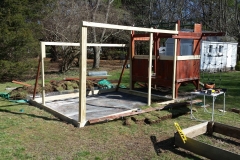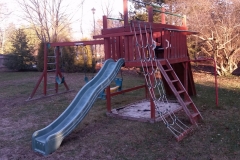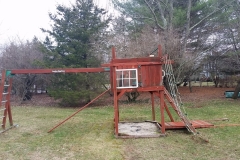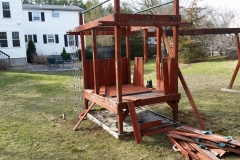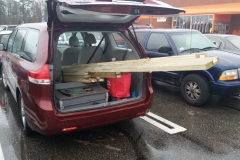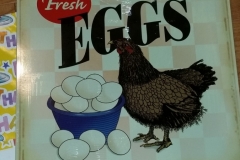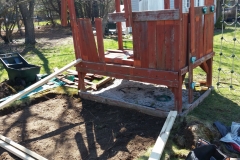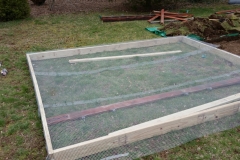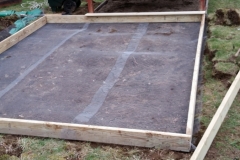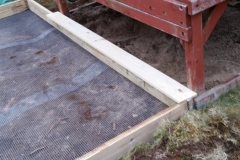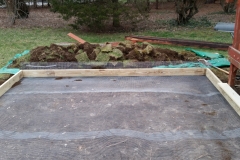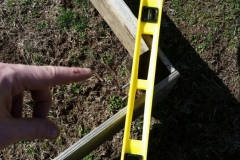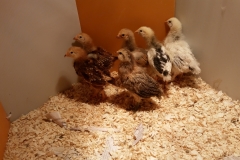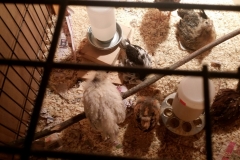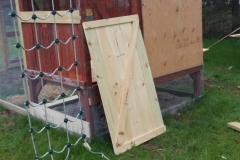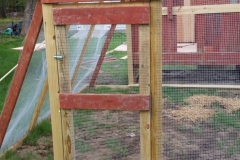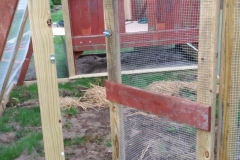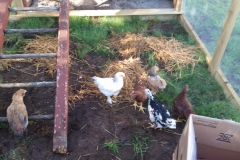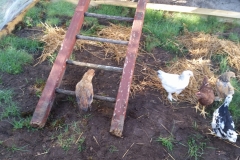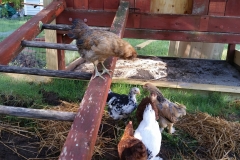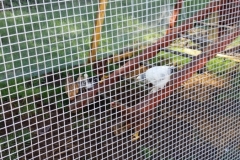In 2016 our kids were getting a bit too old for the swing set, and I got it in my head that it would be fun to convert it to a hen house and get some chickens. There was no basis for this desire – I do not come from farmers, and we hadn’t really talked about getting chickens. But they were becoming trendy, and it seemed like a fun DIY project to tackle. I did have one friend who had backyard chickens, and she became my ‘expert’. For my birthday we got a book on backyard chickens, but my focus was always about the construction zone.
I started the demo in a mild December, and ordered the chickens for a March-April arrival. We were getting 6 baby chickens of various breeds. My general plan was to lower the treehouse so it would be easy for humans and chickens to get in and out. I would cage in the swing set area for the chickens to roam. We weren’t look for free-range chickens as we do have a decent amount of predators in the area. I was also looking to reuse as much as possible from the swingset.
The pictures below show the original swing set (Creative Playthings Durango I believe), and progress through the project as well as the chickens as they grew over time. We were quite ready to move them out of the house once the weather warmed up enough for them to be safe, and I was racing to make it complete and safe for them.
Some specific notes from the project:
* I dug down into the earth and laid down landscape cloth to prevent any weasels or other rodents to get into the chicken run. Landscape cloth has a thinner opening (1/4″) than chicken wire, and would have a longer durability. Attaching it to the wood was tricky with a combination of nails, screws, and staples depending on where I was in the project. We used landscape cloth for all coverings – paid more, but nothing has gotten into the area except for a toad.
* I lowered the tree house enough so that the gangplank coming out wasn’t too steep, and still had room under the house for the chickens to hang out in a sandbox area which they really like. Over time, I have added plexiglass or plastic wrap around the sandbox area so they have protection from wind/snow/rain while they’re outside.
* The old hand-over-hand monkey bars is a great place for them to hang out.
* Two new roofs – Plastic sheets for the chicken run lets them get plenty of light and not too much rain. The hen house has a more traditional shingle roof.
* I thought about doing external access to the roosting boxes, but having another entry point to the house adds a lot of work, so we just put boxes near the door and that’s where they end up. For some reason the hens all seem to like the same box.
* I used branches from the woods for their roosts, and four years later they still seem to like them just fine.
* Entries. We still have a manual guillotine door with a string attached near the main entrance. We lock them up every night, and maybe some day I’ll get a solar sensor door mechanism, but for now the only work I need to do for the chickens daily is in the morning when I bring out their food and fresh water (we keep the food indoors at night) and open the door/windows, and at night when I lock them out and toss the water and retrieve the food. If we’re gone for a night they are fine, they go to bed at dusk and will be safe.
* Predators. We had a hawk or eagle swoop in and get a talon of feathers from a hen who was up against the landscape cloth, but no further damage from that attack. We also saw a fox trying to figure a way in through the top, which we managed to chase off. Otherwise our fence seems to keep most animals away as even in the winter there is no sign of animals checking out the hen house.
* Head count. We ordered 6 hens, had the good fortune of TWO of them being roosters which we rehomed. One of the remaining four had a problem with eating everything and not staying healthy which resulted in one expensive vet bill for an impacted crop. When she did it again I chose a more affordable option.
* Egg count. The Rhode Island Red as expected lays about 6 eggs a week and for 8-9 months of the year. The others are good for 3-4 a week, and only on nice weather. This year they seem to have stopped quite early, with just a few of the Rhodey eggs on any given week.
* Names. The remaining three are Nope (the white one), Rider (the RI Red), and Shelby. Barbara is the black mottled chicken in the pictures. I forget the rooster names – One was Rose I believe.
My general design has been copied on other buildings I’ve made – bike shed, wood shed, and a cage for our berry garden. My roof is always a 1-2′ foot flat slope, and I try to put my pillars a distance that makes sense for the walls (4′, 6′, 8′) but minimize cost. I’m quite pleased with how the whole project has held up. I made the rear wall slanted because of the pieces I had, and that does cause some issue with rain/snow, but the hens don’t really mind. In the winter i put up plastic wrap about 3′ up on the sides so they still have a dirt/hay area to scratch at on most days. I’ve also invested in a small surface heater and most importantly a water heater which GREATLY reduced the work I had to do in the winter.
Future
We may get another small flock of chickens, and if we do we need to have a space for them to quarantine before joining flocks. We have some rough plans for a chicken tractor – a small hen house on wheels that you can move around and we would build for more temporary housing.
